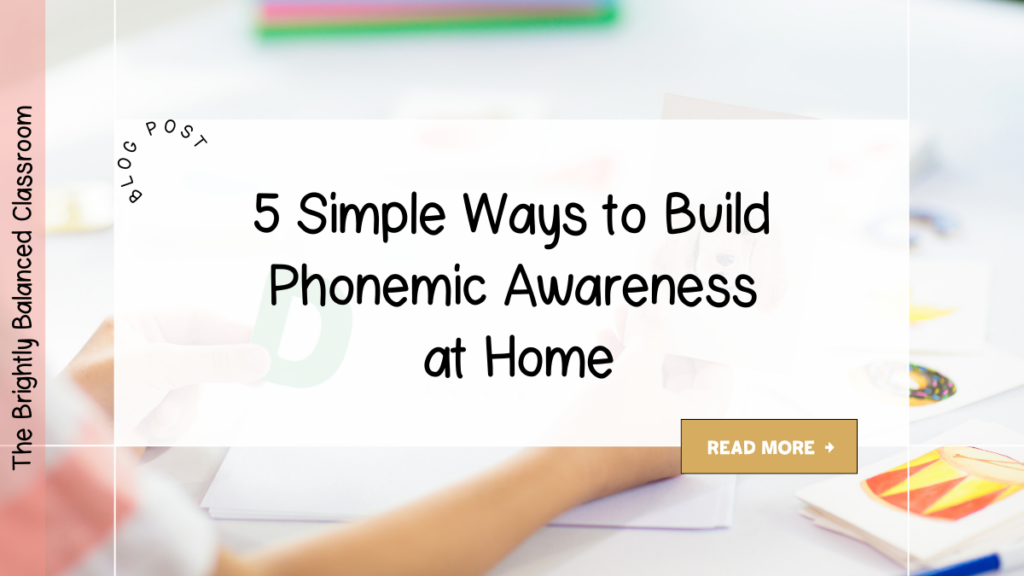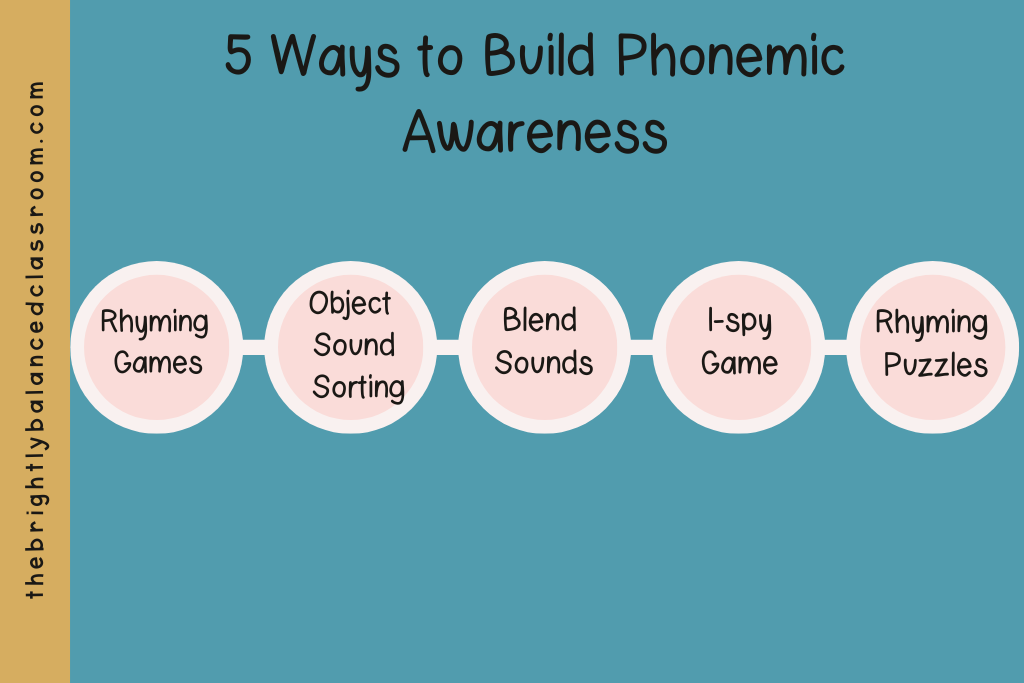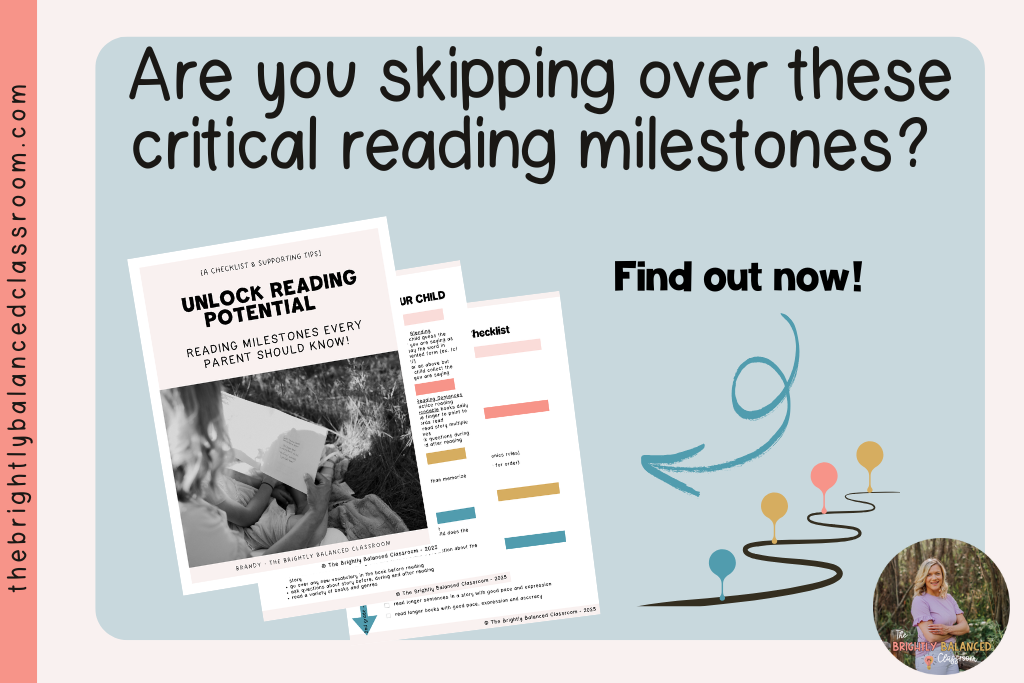5 Simple Ways to Build Phonemic Awareness at Home
Phonemic awareness is probably not a familiar term unless you are in the teaching world but it is one of the most important terms when learning to read. Phonemic awareness is a student’s ability to hear sound and discriminate sounds within words.
For example, can your child tell you the word you are saying if you state it in segmented form? Such as /c/ /a/ /t/.
What about can they tell you a word that rhymes with log?
Or can they tell you the sound at the beginning of the word sun?
What if you say to take away the first sound of ‘sun’ and replace it with a /f/, do they know the new word is fun?

Phonemic Awareness Importance
So why is phonemic awareness so important? Well imagine your child knows all their letter sounds and can even decode (sound out) the word dog as /d/ /o/ /g/. When you ask them to blend the sounds together to read the word they aren’t able. Well then they don’t have strong phonemic awareness and can’t hear the sounds they’ve heard to blend them together. Therefore, it is important we teach this skill to students as the first step in learning to read. This blog post here goes more into detail.
Phonemic Awareness Activities
The best part about phonemic awareness activities is that you can practice them anywhere and mostly don’t need materials to do so. These simple activities can take as short as 3 minutes a day, but they yield such high results. So try these activities and make them a part of your daily routine. This can be during car rides, walking around the grocery store, while cooking dinner or out on a walk.
Rhyming Games
There are many different ways to play rhyming games. Some can be done verbally, while others can include pictures and puzzles.
One of my students favorites is a movement based rhyming activity. In this Write the Room Phonemic Awareness activity students move around a room or classroom to find cards with two pictures. Students use their recording sheet to determine if the two pictures rhyme or not. Here is this activity which is always a popular one.
Here are a few ways to play some verbal rhyming games. Ask your child to tell you a word that rhymes with another word. For example, “I am thinking of a word that rhymes with dog.” Your child can then tell you words that rhyme with dog.
Or you can say “I am going to stay two words and you put your thumbs up if they rhyme and thumbs down if they don’t rhyme.” Then you will state two words. Make some of these word combinations rhyme and some not.
Finally you can make this more engaging by having your child “quiz” you but really they are the ones strengthening their phonemic awareness skills. Have your child state a word and then you will tell them a word that rhymes with it. It will be important for you to sometimes answer correctly with rhyming words and also answer incorrectly with a word that doesn’t rhyme.
Object Sound Sorting
This activity is simple and hands-on. Gather 10 items from around your house and sort them by beginning sound. Put all the items that begin with the sound /m/ (for example) in one pile and all the objects that begin with /s/ in another. It will be important to state the name of each object and emphasize the beginning sound.
Blend Sounds Together
Play a game where you say to your child “I am thinking of a word in my head. Can you guess it? My word is ….” You will state the word you are thinking of in segmented sound, by which I mean say each sound heard in the word. Try to use words with only 3-4 sounds to begin with. For example, “I am thinking of a word. Can you guess it? My word is /d/ /o/ /g/.”.
Again, you can reverse this and have your child have you guess the word they are thinking. This is activity is great because children are learning an important part of phonemic awareness which is segmenting (taking sounds a part) and blending (putting sounds together) words.
I-spy sounds
There are many ways to build phonemic awareness and different skills to be practiced using the simple game of I-spy. Here a few examples:
Rhyming words can be practiced by stating, “I-spy something that rhymes with (ex. dog)”
Beginning sounds can be practiced by stating, “I-spy something that begins with the sound /b/”.
Blending sounds can be practiced by stating, “I-spy something that is a /d/ /o/ /g/.”.
The best part about I-spy is it can be done anywhere and you don’t need any materials.
Rhyming Puzzles
Building puzzles with rhyming pictures is a great way for students to match rhyming words using a hands-on approach. When teaching new skills it is important to use a multi-sensory approach. Building a puzzle is a great multi-sensory approach to learning.

Phonemic Awareness Recap
Building a strong reading foundation begins with building strong phonemic awareness, which is the first step in learning to read. Helping your children build early literacy skills doesn’t need to be complicated or time consuming, but rather the opposite with fun, engaging learning with time for connection. Are you wanting to know your child’s understanding of phonemic awareness as well as use a few activities to support their growth? This phonemic awareness activity and assessment pack is perfect for Preschool and Kindergarten.
Building phonemic awareness is a crucial step in developing early literacy. Eliminate scrolling for ideas and ways to support early literacy development for your child. Grab this Reading Milestones Checklist to ensure you’re on the right path without ever skipping a step.

Related Articles:
Leave a Reply Cancel reply
Template by The Creative Impact
Template by The Creative Impact
Copyright 2024-2025 | The Brightly Balanced Classroom | All Rights Reserved |
Browse the site
Work With Me
This website is a participant in the Amazon Services LLC Associates program, an affiliate advertising program designed to provide a means for sites to earn advertising fees by advertising and link to amazon.com.
This website is not intended for children under the age of 13.